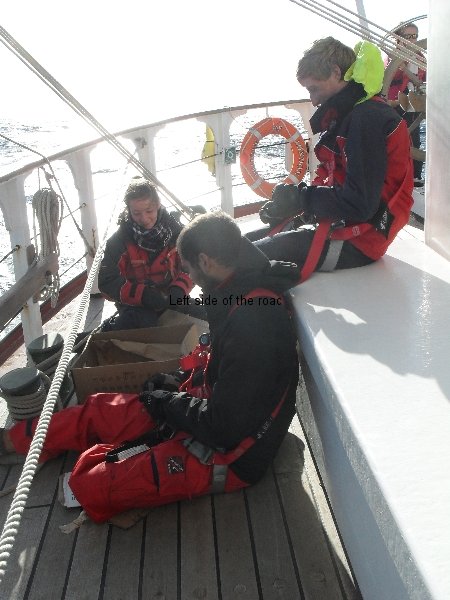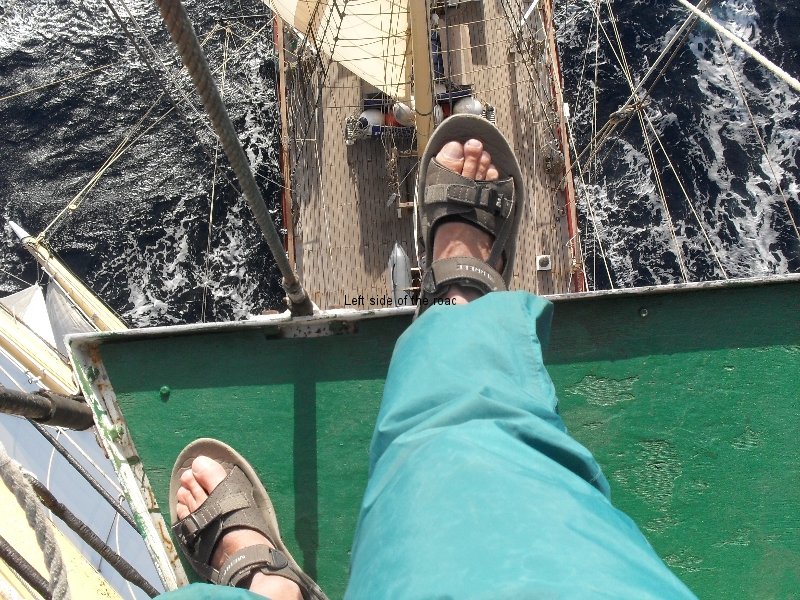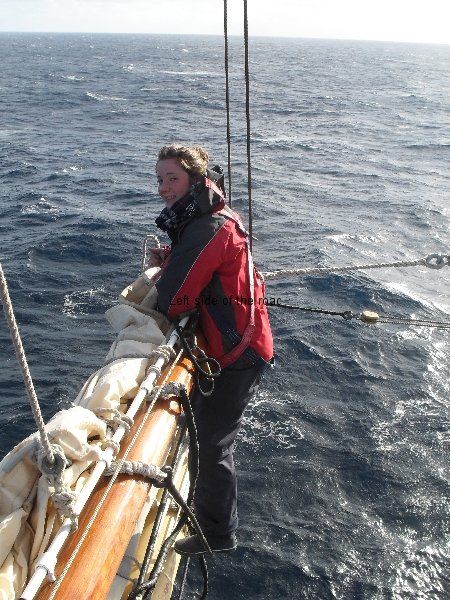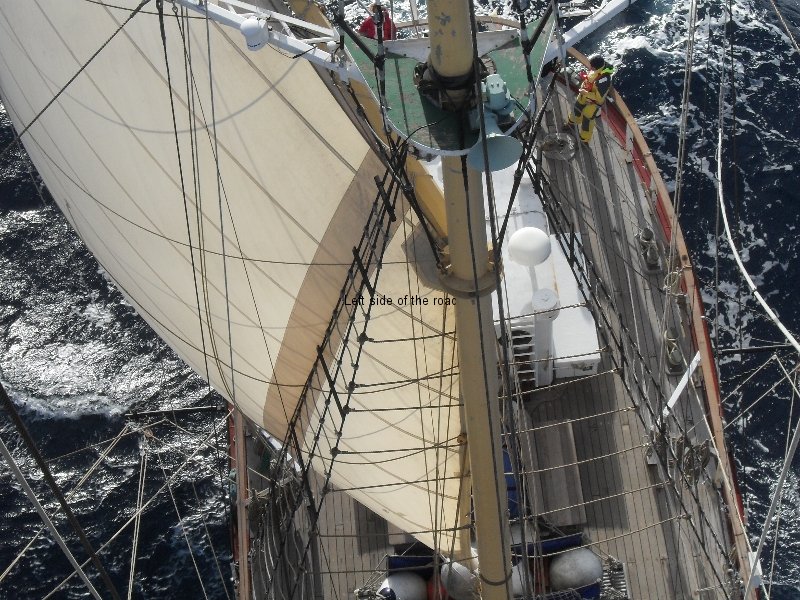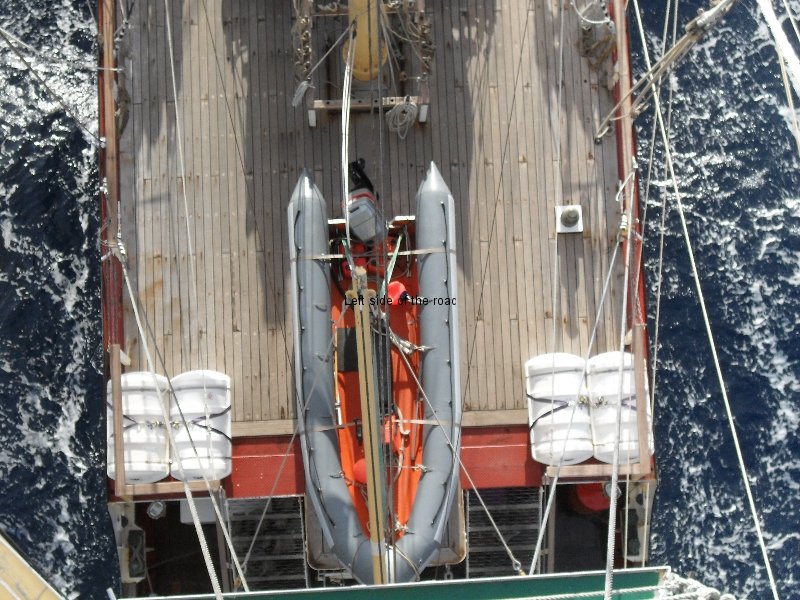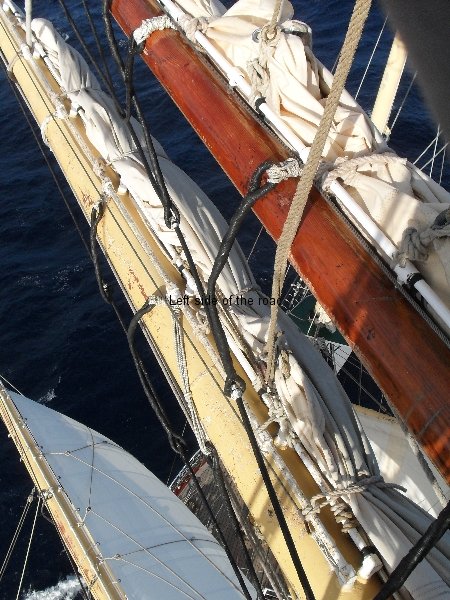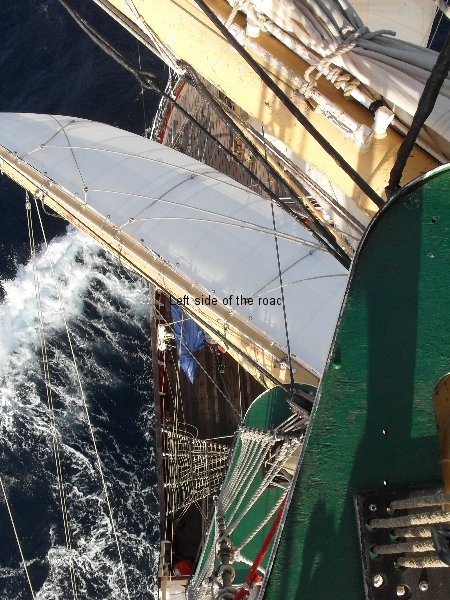
View from the helm of a tall ship
More on sailing on a tall ship
One of the two principal tasks when on Watch is to take control of The Helm (the other is the look-out, to make sure you don’t hit something – or something hits you). The Helm is the driving seat (although you stand up) of the vessel and is welcomed – or not – very much depending upon the weather.
(So I don’t get accused of teaching grannies how to suck eggs I will assume, for the benefit of this post, that the reader knows absolutely nothing about the workings of a tall ship – very much as I did before getting on board 2 months ago.)
The first thing to stress is that The Helm is at the back of the ship which is like driving from the boot if you’re a car driver. Also you can’t see where you’re going, there’s the wheelhouse and the sails in the way. And anyway, at least for a huge chuck of this voyage it didn’t matter that you couldn’t see where you were heading as all that could be seen from the front was sea, and more sea. It’s for the look-out to make sure that you don’t hit anything.
The helm itself is a big wheel (about 4 foot in diameter) that is as far as it is possible to be at the stern (the back or the blunt end) of the vessel. Go any further back and you’re in the water. This wheel is not protected in any way from the elements. That was OK when we were in the Caribbean, when ‘the elements’ were basically the blazing sun, but it becomes a different matter when heading further north into an uncertain late European winter/early Spring.
That has meant that since we started the northward/eastward journey we have encountered more rain and the wind can be ‘bracing’ as they say. In fact, one thing that has been surprising, to me and others, is the way air temperatures have remained fairly constant and relatively high. To take a random date (when I wrote a first draft of this post) the 11th March, both the day and night-time temperatures were around the 13°C level – and at the time we were heading towards the Bay of Biscay. So it’s not necessarily the air temperature falling that makes it cold on The Helm, it’s the wind chill that you get either from the following wind that fills the sails or the wind created by the vessel itself when under power.
There is a helm under cover. That’s in the wheelhouse but that’s just there to taunt you as you fight against the gale force winds (which we had on four or five occasions) and the face stinging rain that normally accompanies the occasional squalls that we encountered with increased frequency. This wheel does work (it was tested when we were shown what would happen in the event of the wheel being put out of action for any reason) but it has never been touched in anger, to the best of my knowledge.
As this is a training ship the policy to keep The Helm outside is probably all about building character, but personally I’d rather have no character and be warm.
At the same time, to be fair, a proper, professional helmsman/woman on a sailing tall ship such as this would need to be able to see and hear how the sails are reacting to the wind. They can remain stable for a long time but the changes of wind speed and direction can happen quite quickly at times, again especially as we head north into more uncertain climatic conditions.
So that sets the picture.
What does being on The Helm entail?
Basically obeying the orders of the Officer of the Watch and looking at 4 dials that give you the information you need to understand what is happening.
I’ve forgotten to mention that actual helm of the vessel is powered by hydraulics, it would be impossible for one person to move the rudder on such a ship without powered assistance of some kind. The speed at which the rudder reacts depends upon a number of factors; the speed of the vessel at the time; whether it is under power or under sail; sea conditions, i.e., how rough it might be (a big wave can push you off course by an amazingly high level of degrees); as well as the ability of The Helm operator.
So the 4 dials to watch, from left to right, are: the wind speed indicator; the wind direction indicator; the dial that shows the position of the rudder; and the compass heading. These are illuminated at night and are all replicated inside the wheelhouse so that the Duty Officer (who doesn’t have to stand out in the elements) can see what is happening in the outside world as well. If the weather conditions are not bad it’s quite easy to take in this information. If you hit a squall and it lasts for a while then the driving rain makes reading the dials slightly more difficult.
In general, being at The helm is fun. Here you are basically controlling this 114 foot, 250 tonne vessel, on the high seas. In a sailing ship all the crew does is prevent the vessel from going where it wants to go so The Helm is where that all happens. For example, if the ship naturally wants to go towards the port but your desired direction is to the starboard this means there is a constant ‘fight’ between the two forces.
And the physical experience is dependent upon the weather conditions. In the Caribbean the seas were quite gentle, as were the winds, and it was relatively easy to follow the heading given. But when we started getting into the heavier and more aggressive open waters of the Atlantic it became more of a battle, and you knew you had been working if you were constantly moving the wheel to keep on course. The hydraulics make it possible for a single person to control the rudder but it’s not the same sort of powered steering that you get on an articulated lorry.
Sometimes you might be told to steer not on the compass heading but by reading the wind direction. Here you guideline is that you must try and keep within a certain part of the wind direction indicator ‘clock’ – it’s divided up as a clock would be into 12 units and your guideline might be to keep with 25 and 20 to the hour (not the way it should be described, that involves degrees, but the easiest way for novices to understand). Failure to do so could mean that the wind gets on the ‘wrong’ side of a sail and the consequences can possibly be quite dire. The breaking of the boom on the spanker on the TransAtlantic crossing leg of the journey was probably due to this backing of the wind. It’s from this situation that you get the saying ‘sailing too close to the wind’.
From what I understand anticipation of what will happen is the key to working successfully on a tall ship. If you leave your adjustment until it starts to show then you have left it too late as the vessel takes some time to understand what it should do, this is even more so in rough weather when the rudder might be spending some time out of the water. This might make it difficult for experienced yacht sailors as those vessels respond much more quickly. And you won’t make many friends below decks if you are constantly following instead of leading at The Helm as the ship will tend to rock back and forth making any objects not nailed down fly around at random.
One thing I’ve found interesting about being on The Helm is your impression of speed. If it is at night and the wind is behind you, blowing relatively strong (i.e., 20 – 30 knots) you think you’re racing along even if you’re not. If you’re sailing during the day, with the winds negligible and therefore under power, you get the impression you are barely moving when you might be doing 5-6 knots, which isn’t a bad speed for such a vessel.
And as to speeds they have varied, as you might expect, on such a journey. With little wind and the engines on we can expect about 6 knots. But when we had the most favourable winds in mid-Atlantic we were clocking up more than 11 knots for short periods of time. That meant it was quite uncomfortable down below but we certainly clocked the miles then and that helped us to do the crossing from Bermuda to The Azores in less than 14 days.
Since we leaving the warmth of the Caribbean being on Watch, and especially at The Helm for any length of time, a wind proof jacket is vital. As mentioned above the air temperatures have been fairly, and surprisingly, high and constant but the wind chill is what gets to you.
Although I haven’t been too successful in capturing it on film another aspect of being on The Helm in bad weather is that you are totally oblivious to the walls of water that build up behind you. The vessel has been very adept at dealing with these types of conditions but the way the vessel rises on the crests of waves and then shoots down into the troughs makes for an unforgettable picture in your mind of the power of the ocean.
Under normal conditions you wouldn’t be on The Helm for more than about 30 minutes. In conditions which are in any way challenging you need to concentrate and that would be lost if you tried to stay on too long, especially for non-professionals. This is even more the case during a night Watch. The red compass heading dial becomes quite mesmerising as it ticks away virtually every second. You try and follow the course given but with modern equipment you are trying to do what would have been impossible in the past. Before modern electronics The Helm would have followed the general course as well as they could but it would then have been corrected over a period of hours rather than a period of seconds.
But it’s not just a matter of standing and occasionally turning the wheel. If you hit either rough weather or you have a favourable wind which will tend to make the ship list to one side you have to move to maintain your centre of gravity at such a point that you can remain standing. This means you have to bend your legs to compensate for the listing and this would be an acceptable exercise regime for Premier footballers. And although you have hydraulics assisting the wheel it still needs effort to turn that wheel, especially if a quick correction is called for, and your arms and back feel the strain after a difficult Watch.





